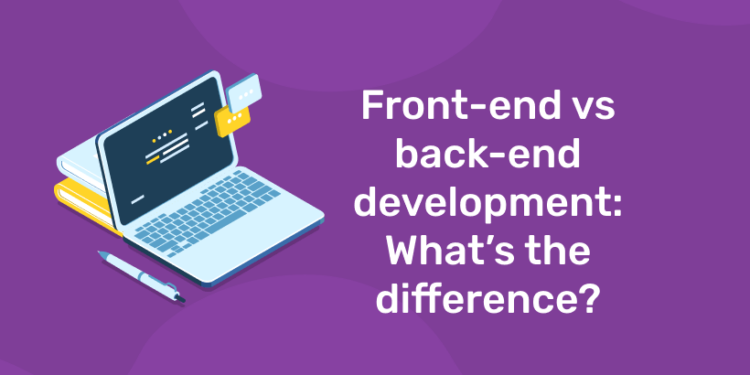Table of Contents
Front-end, back-end and full-stack developers are responsible for creating a website’s complete look, feel and functionality. They have specific roles and skills for creating the necessary codes that differentiate each role from the other. Together these developers are responsible for all the aspects of a typical web page—from the URL to page layout, interactive functionality and graphical interface. In this blog, we discuss what front-end, back-end and full-stack development are and list the main differences between them.
What is back-end development?
Back-end development refers to creating and ensuring the well-running of a website’s internal operations, which are hosted by a server. A website’s back-end is its server, application and database, so a back-end developer focuses on setting up and maintaining databases, scripts and the overall website architecture. The primary responsibilities of a back-end developer include:
-
Understanding the website’s main objectives and finding various ways to facilitate them
-
Making sure that data is properly stored and that users who want to access it can do so quickly and easily
-
Managing application programming interfaces and making sure they work across devices
-
Setting up payment systems when necessary, including allowing the user to input their data, making sure the respective data is stored securely and making changes to the payment when necessary
-
Organizing a website system’s logic and optimizing it to run properly on multiple devices
-
Creating website architecture that can easily be modified with future upgrades
-
Implementing various algorithms and resolving various challenges regarding the system
Start your coding career here!
What is front-end development?
1: Which of the following is a JavaScript framework/library?
Front-end development refers to creating and maintaining the part of the website that users directly interact with. Front-end developers need to create a website’s entire interface and user experience, as well as it’s design and overall look. They usually work with HTML, JavaScript and CSS languages to create a basic layout of the website and then add various visual elements to improve its esthetic quality. Some of the most commonly performed tasks for a front-end developer include:
-
Optimizing the user’s experience on a website and making sure it’s not interrupted by any design or functionality issues.
-
Creating rough concepts and using HTML, CSS and JavaScript to materialize them.
-
Developing an easy-to-use and intuitive user interface and gradually improving it based on user feedback.
-
Adapting a website’s design to look and function properly on mobile devices.
-
Making sure that a website looks and functions according to the same parameters regardless of the internet browser that the end-user chooses to open it with.
-
Helping with organizing and managing the entire software workflow.
-
Constantly testing the website’s front end for ease of use and potential errors and optimizing it to ensure a smoother user experience.
-
Considering SEO practices when creating a website’s front end to ensure that it’s correctly indexed by search engines and users have easier access to it.
What is full-stack development?
Full-stack development is a combination of back-end and front-end development. Given the wide variety of methods, languages and types of websites currently available, there is no official distinction regarding a full-stack developer’s attributes. As a general description, full-stack developers can perform all front-end and back-end programming tasks with little or no assistance, including aspects regarding servers, databases, user experience, hosting, data modeling and other aspects necessary for a website to run properly and be visually appealing.
Given the fact that full-stack developers have a dual skill set, they are usually very popular with employers, as they tend to be more efficient. Some of the most commonly performed tasks by full-stack developers include:
-
Helping the software design and development teams
-
Optimizing software through constant testing and debugging
-
Writing code for both the front and back end of a software application
-
Making sure that the website runs on multiple platforms
-
Designing a web application’s user interactions
-
Working on the back end of the software and implementing servers and databases
-
Working with graphic designers to create and implement new features
-
Keeping their software up to date with the latest industry developments
-
Communicating with the hiring company’s decision-makers
-
Resolving various issues with maintenance, security and scalability
Back-end vs. front-end vs. full-stack development
Here are some of the main differences between back-end and front-end development:
-
The front end refers to the graphical user interface required for navigating a website, including its overall layout, videos, images, text, buttons and every other visual element, whereas the back end solely refers to the way the website should function.
-
Back-end development typically focuses on the application of logic to solve various functionality and user experience issues, while front-end development focuses on making the website look good and provide a positive user experience.
-
Front-end development collects user input, while back-end development processes user inputs.
-
Issues like search engine optimization and user accessibility are handled by front-end developers, while those related to the website’s security and backup are the responsibility of back-end developers.
-
Front-end development uses markup and web languages like HTML, CSS and JavaScript, while back-end development uses programming and scripting languages like Ruby, Python, Perl, PHP and .Net.
Full-stack development can’t directly be compared with back-end and front-end development, since it essentially refers to a mix between the two.
Salary and job outlook for back-end, front-end and full-stack development
The average salary for a back-end developer in the U.S. is $120,500 per year. They also often earn other benefits, like stock options, PTO and health insurance. Front-end developers can expect to earn an average salary of $105,491 per year, plus similar benefits to back-end developers. Full-stack developers earn an average salary of $107,248 per year, along with similar benefits to the other two roles.
According to the U.S. Bureau of Labor Statistics, the job outlook for web developers and digital designers, which includes these three roles, is expected to grow by 8% between 2019 and 2029. This is much faster than the national average. It’s estimated that the reason behind the significant growth in demand is the increasing popularity of e-commerce and mobile devices.











